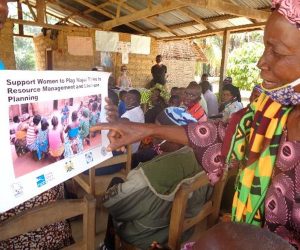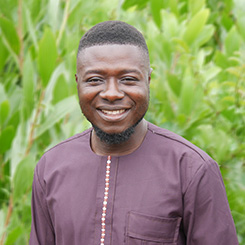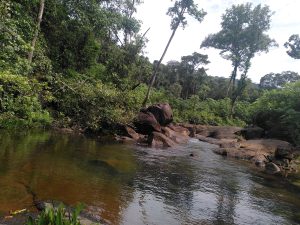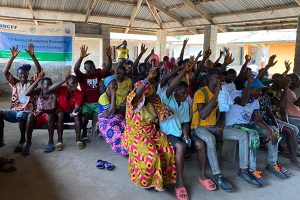Background and overview
The Gola Darwin project operates in the Kailahun District, in Malema chiefdom targeting 14 forest edge communities. Linking food security to biodiversity conservation is a key in achieving the goal of the conservation of the Gola Rainforest. By helping forest edge people sustainably increase their crop yield and keeping annual deforestation of their community forests (CF) low, we manage to preserve the forest.
The project is divided into four components, namely: landuse planing and co-management, agriculture, community/environmental awareness and biodiversity research.
Situation we are facing
Gola Rainforest National Park (GRNP) supports 60 globally threatened species (GTS), including the regionally important western chimpanzee population, the largest known pygmy hippo population, forest elephant, white-breasted guineafowl and white-necked picathartes. The first REDD+ project in West Africa protects GRNP and surrounds by working with forest communities. A 4km leakage-belt encompasses 122 settlements. Inhabitants are amongst the poorest in Sierra Leone (average annual household income $150). 77% rely on subsistence agriculture; 85% derive income from one livelihood. Only 4% produce enough rice to meet their annual needs. Problems include: low yields, storage losses, poor market access and gender-inequality (Of the 19% female-headed households, only 42% have access to land).
Increasing population combined with poor soil fertility drives agricultural encroachment into community forest which has no formal protection, but provides vital habitat for GTS and may link blocks of GRNP and Gola Forest National Park (GFNP) in Liberia.
Currently, communities receive REDD+ payments in exchange for not encroaching on GRNP. Communities also receive agricultural training designed to improve livelihoods and to reduce the need to exploit community forest. However, since 2015, deforestation-rates in community forests have risen relative to baseline. Whilst some deforestation is inevitable, identifying and protecting High Conservation Value Community Forest (HCV-CF) would reduce negative impacts. Linking HCV-CF protection to tailored support to increased yields on existing farmland through revised Conservation Agreements with communities could benefit livelihoods and GTS. Embedding HCV-CF into Community Forest Management Plans (post-project) would secure an effective mechanism for reducing deforestation. Project communities are ‘squeezed’ between GRNP and GFNP, threatening to encroach important GTS habitat. This project will enable communities to demonstrate how the REDD+ project can help them conserve HCV-CF while meeting livelihood needs.
Our goals
The Gola Darwin project protects Gola Rainforest National Park (GRNP) by helping forest-edge people sustainably increase crop yield, keeping annual deforestation of their community forests (CF) <2.5%.
However any deforestation risks losing High Conservation Value (HCV) Communty Forests, which provide habitat for globally-threatened species and connect GRNP with protected Liberian forests. The project identifies the most important community forests for biodiversity and empower communities to protect it through tailored training to increase food security, linking it with zero-deforestation in HCV areas.
Our approach
Our approach in achieving the goal of the project is through roadshows and radio broadcasts and close contact with the communities.
Our activities
To create awareness among Malema communities of the importance of maintaining forest and biodiversity and to train them to take an active role in conservation and monitoring as a tool for long-term sustainability.
Outcomes which we want to reach
By the end of the project target communities (182 households, 1,494 people, 778 men, 716 women) in Malema chiefdom will have demonstrated that food-security can be improved sufficiently to allow them to protect as ‘Zerodeforestation zones’ ca. 25% (1000-1,500ha) of High Conservation Value Community Forest (HCV-CF) i.e. habitat for globally-threatened species. In addition, a commitment will have been made to roll-out this demonstration across the remaining 19 villages (2,017 people, 1,050 men, 967 women) of the Malema chiefdom, and in the long term the entire leakage-belt (22,000 people, 11,440 men, 10,560 women).
News about our work through the Darwin Initiative

Darwin Initiative supports Gola communities
Increasing deforestation puts biodiversity under threat Increase in human population in recent years has led to increased pressure on forests by local communities for livelihoods

Darwin Initiative Increases Forest Conservation Awarness
In its continued drive to promote conservation work in the Gola landscape, the Conservation Society of Sierra Leone (CSSL), in collaboration with Gola Rainforest Conservation

Kobba Bobson
Community Development Facilitator
More information
For more information or if you want to engage yourself in this project please contact our Community Development Facilitator Kobba Bobson: kobba.bobson@cs-sl.org



